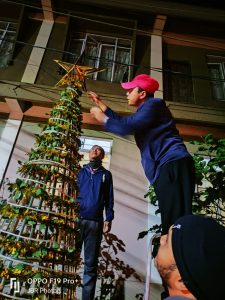This festive season round, Christmas has taken a cultural turn as homes, villages and localities are decked up for the holidays. Three cone figures stand tall in one of Shillong’s oldest localities in Jaiaw Lumbatemon, under the Dorbar Shnong Jaiaw Laitdom. One look at what has now become the art installation representing Khasi traditional crafts, can connect the beholder with the past, intersecting in the present with efforts to embrace the future.
With indigenous ideas originating from the youth of Lumbatemon, the three figures that look like Christmas trees with lights, were actually crafted from bamboo culms by skilled craftsmen of Nongtariang village in Ri-Bhoi district. The three cones between 7 and 12 feet tall seem to represent the Christmas nativity story of old where the baby, the mother and the father were present in a manger.
On the social front, the Christmas art installation also seems to represent the completion of the community cleaning drive, a local public practice to draw the community together in cleaning neighbourhoods and ensure cleanliness. Practically, after the cleaning drive, traditional Khasi baskets called Khoh are placed upside down, in a way sending a message that the cleaning of the village is done and public hygiene will therefore, remain the mainstay. Though this kind of idealistic notions seem far-fetched for the likes of present Shillong, hope prevails to propel the city’s organic identity and community’s responsibility to bounce back.
 As it is, three as a number is a very significant numerical concept of the Khasi people as much as it is a numerical prominence universally. Primordially, the number three defines and cuts across theological and social completion connected to faith and family respectively, hence, the significance of the three cone figures. The open-endedness of the installation is artsy and organic enough to give space to the critics, as if the artist-figure is standing at the door and knocking gracefully.
As it is, three as a number is a very significant numerical concept of the Khasi people as much as it is a numerical prominence universally. Primordially, the number three defines and cuts across theological and social completion connected to faith and family respectively, hence, the significance of the three cone figures. The open-endedness of the installation is artsy and organic enough to give space to the critics, as if the artist-figure is standing at the door and knocking gracefully.
The flip side of the three figures is reflective of the story of Christmas, where the three wise men from the east travelled from afar to reach the place where baby Jesus was born, in present day Israel. It was there, next to the manger that the three wise men knelt down and offered gifts of gold, frankincense and myrrh.
The cone figures narrow smoothly from a flat base to a point which forms the axis to the centre, where one can see three stars lighted up on top. Of course, the rice lights complete the look and feel of the three figures mesmerising the eyes especially on Christmas nights.
The locality’s youth had put up much physical and creative efforts to turn the spot into a natural selfie point where thousands of passers-by stopped to click a pic with their mobile phones. If culture and religious festivity should meet, if indigenous practices and artistic expression should bump into each other and if inclusivity of faiths and traditional heritage should brush shoulders, the three cone figures are one natural example, as if wishing the passers-by ‘Merry Christmas’.
(By our special correspondent)



